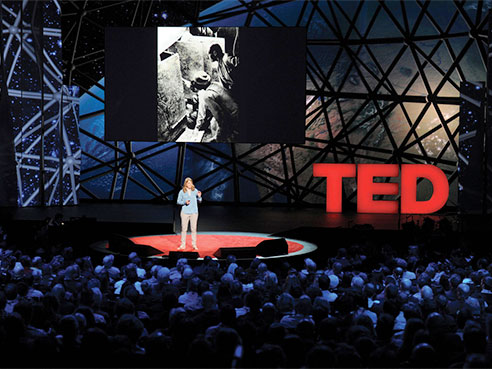Need more info? Contact us
 Dr. Parcak’s TED Talk is live today.Dr. Sarah Parcak, a space archaeologist, today officially launches GlobalXplorer: a citizen science and archaeology platform that’s enlisting people around the world to discover sites unknown to modern archaeologists.
Dr. Parcak’s TED Talk is live today.Dr. Sarah Parcak, a space archaeologist, today officially launches GlobalXplorer: a citizen science and archaeology platform that’s enlisting people around the world to discover sites unknown to modern archaeologists.
Dr. Parcak is the 2016 TED Prize winner, a National Geographic Fellow and professor at the University of Alabama at Birmingham. GlobalXplorer is the result of Dr. Parcak’s TED Prize, which is granted each year to one exceptional individual, offering them $1 million and the resources of the TED community to create a world-changing project. Dr. Parcak wanted anyone with an Internet connection to “discover and protect the millions of unknown archaeological sites across the globe.”
Dr. Parcak’s TED Talk is live today. In addition, a complete FAQ on GlobalXplorer is available here.
GlobalXplorer was built in collaboration with the TED Prize, National Geographic, satellite imagery and analytics firm DigitalGlobe (NYSE: DGI), and platform developer Mondo Robot. While GlobalXplorer has ambitions to span the globe, it is launching in Peru, where Sustainable Preservation Initiative (SPI) will serve as the on-the-ground partner.
“The world’s hidden heritage contains clues to humankind’s collective resilience and creativity,” explained Dr. Parcak. “It’s up to all of us to protect this heritage, and with GlobalXplorer we are empowering a 21st century army of global explorers to discover and protect our shared history.”
GlobalXplorer offers gamified discovery of archaeological sites previously unknown to most modern archaeologists, and users are rewarded for their valuable time. After signing in and taking a tutorial, users begin examining satellite images. The longer they spend on the site, the more rewards they collect: from rich content about Peru, to secret behind-the-scenes sneak peeks, to actual leveling up. Eventually, users have the opportunity to join archaeologists (virtually) for on-the-ground digs.
“Every year, we have the honor of working with one inspiring individual to create and execute a brilliant, impactful idea,” said Anna Verghese, TED Prize director. “Dr. Parcak’s wish has put the tools in everyone’s hands to discover and protect humanity’s rich history, effectively opening up a traditionally closed discipline. Now our stories are safeguarded by millions rather than just a handful.”
Preventing looters from finding new historical sites was central to building the GlobalXplorer platform. The high-resolution satellite images are broken into tens of millions of small tiles and displayed to users in a random order without the ability to navigate or pan out. The tiles do not contain any location reference or coordinate information.
| “Dr. Parcak’s wish has put the tools in everyone’s hands to discover and protect humanity’s rich history, effectively opening up a traditionally closed discipline. Now our stories are safeguarded by millions rather than just a handful.” |
DigitalGlobe, the global leader in earth imagery and information about our changing planet, is providing more than 200,000 km2 of satellite imagery of Peru and a customized version of its online crowdsourcing tool, Tomnod, for GlobalXplorer. DigitalGlobe’s Geospatial Big Data platform, GBDX, is the engine of this project, handling the image ordering, processing, custom tiling, and data hosting necessary to achieve the desired scale and objectives of the project.
"DigitalGlobe is thrilled to expand our partnership with Dr. Parcak and provide the tools that citizen scientists around the world will use to discover sites not yet known to modern archaeologists,” said Caitlyn Milton, DigitalGlobe Customer Success Manager. “By combining high-resolution satellite imagery and crowdsourcing, GlobalXplorer will empower archeologists to make decisions with confidence, and in doing so, preserve relics of our shared human story.”
National Geographic is providing archaeological expertise and rich content while supporting GlobalXplorer with complementary educational resources. SPI empowers people, the majority being women, in communities near archaeological sites and is working with GlobalXplorer in Peru to preserve and protect the archeological sites identified by the platform.
“Dr. Sarah Parcak’s work exemplifies National Geographic’s commitment to furthering exploration and inspiring people to generate solutions for the greater good,” said Alexander Moen, vice president of Explorer Programs at the National Geographic Society. “By supporting the launch of GlobalXplorer and Dr. Parcak’s wish, we’re helping to educate the next generation about the importance of archaeological sites and, by giving them the opportunity to participate directly in this exciting exploration project, we are connecting them to our shared cultural heritage.”
Dr. Larry Coben, founder and Executive Director of SPI, says, “We are thrilled to be Sarah and GlobalXplorer’s partner. As soon as they see new or destroyed sites from the sky, we will be there on the ground to investigate and protect them. We will also empower and train the communities around those sites so that they can benefit economically from their heritage without looting and destroying it.”